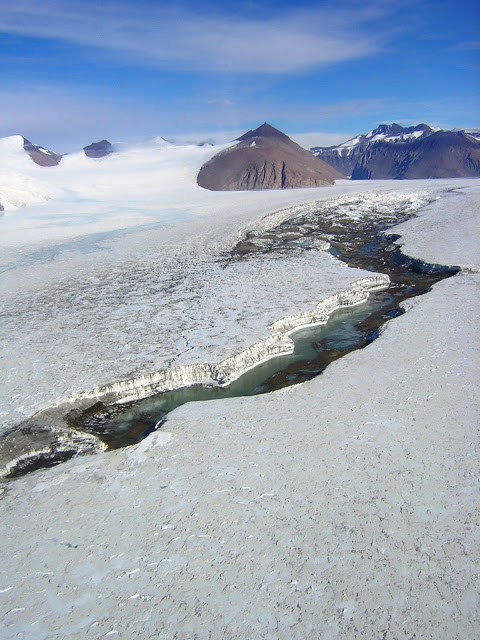

| Online: | |
| Visits: | |
| Stories: |

| Story Views | |
| Now: | |
| Last Hour: | |
| Last 24 Hours: | |
| Total: | |
Polar Glaciers May Be Home To Previously Undiscovered Carbon Cycle
The cycle, they argue, could become a significant global source of carbon as temperatures rise worldwide and microbial activity increases.
An international team of researchers from the United States, Germany and Sweden published their results in the online journal Nature Geoscience.
Previously, scientists thought carbon released into polar streams by glaciers came from ancient organic material locked in the ice, or from newer sources, such as dust and soot blown in from fires and other sources around the world and deposited on the ice surface. Ice melt then releases that carbon into streams, which flow into the sea.

Credit: Christine Foreman, Montanan State University
The researchers found that most of the carbon in the stream was produced by bacteria photosynthesizing — producing food from sunlight — rather than ancient carbon.
Although this is an initial study of the phenomenon, the research could indicate that as global temperatures rise, particularly in polar ecosystems, which are more sensitive to high temperatures, the microbial output of carbon could increase.
Although individual glacial streams overall may harbor relatively small amounts of carbon, they are important on a global scale because of their sheer mass and surface area, the authors write. Approximately 11 percent of the Earth’s surface is covered in ice, and the polar glacial streams “represent an important component of the global carbon cycle,” the authors write.
Because the carbon is easily broken down by the organisms, “it is believed that the impact of this material on downstream ecosystems will be amplified,” said Christine Foreman, a researcher at Montana State University and an author on the paper.
The researchers say that additional studies are needed to refine the picture of whether the balance of carbon produced by glaciers is weighted more to release of ancient carbon or production by microorganisms.
The researchers examined a stream on the Cotton Glacier in Antarctica’s McMurdo Dry Valleys, where NSF supports a Long-Term Ecological Research (LTER) site. The Dry Valleys are the largest ice-free region in Antarctica, representing roughly 2 percent of the surface area of a continent the size of the U.S. and Mexico combined. High winds scour snow and ice from the valleys, creating a landscape that resembles the arid U.S. Southwest, but without any vegetation.
Out of a national network of 28 LTER sites, NSF supports two sites in Antarctica: McMurdo Dry Valleys and Palmer Antarctica.
Diane McKnight, a program officer at NSF, and Foreman are both authors on the paper and associated with the McMurdo Dry Valleys LTER science team. McKnight’s NSF award concluded prior to her becoming a program officer.
Through its Office of Polar Programs (OPP), NSF also manages the U.S. Antarctic Program, which coordinates all U.S. research on the southernmost continent. OPP supported the McMurdo Dry Valleys research through a grant and collaborative award, while NSF’s Division of Graduate Education supported Foreman through an Integrative Graduate Education and Research Traineeship award.

Contacts and sources:
Peter West, NSF,
Christine M. Foreman, Montana State University,
Source: http://www.ineffableisland.com/2017/04/polar-glaciers-may-be-home-to.html


